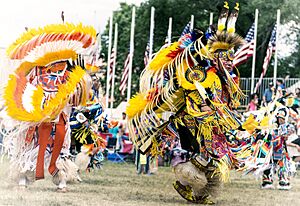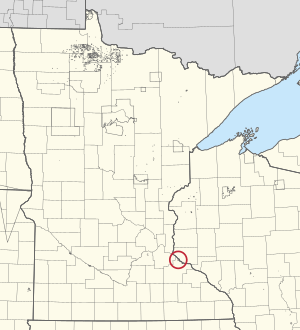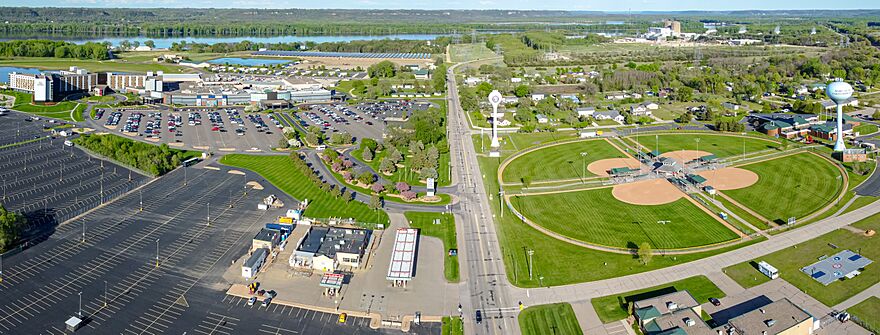Prairie Island Indian Community facts for kids

The Prairie Island Indian Community (in the Dakota language: Tinta Winta) is a special area of land, called an Indian reservation, that belongs to the Mdewakanton Sioux people. It is located in Goodhue County, Minnesota, right next to the Mississippi River. Most of this land is now within the city of Red Wing.
This reservation was created in 1889. Over time, the community has lost some of its land because of two big projects by the United States government. First, the United States Army Corps of Engineers built Lock and Dam No. 3 on the river to help boats travel better. Later, in 1973, the Prairie Island Nuclear Power Plant was built nearby, and more reservation land was used for that project.
The main part of the reservation is in Red Wing. The community also owns other lands, called Off-reservation trust lands, in Red Wing and nearby towns. These extra lands more than double the total area the tribe owns. The reservation and these trust lands together cover about 4.0 square miles (2,600 acres; 10 km2) of land. In 2020, about 310 people lived there. The tribe runs a popular place called Treasure Island Resort & Casino on their land near the Mississippi River.
Contents
History of Prairie Island
Past Government Plans
From the 1940s to the 1960s, the U.S. government had a plan called the Indian termination policy. This plan aimed to end the special relationship between the government and Native American tribes. Four Native American groups in Minnesota, including the Prairie Island Community, were part of this plan.
In 1955, a bill was introduced in Congress to end the special status for these tribes. However, many people, including the Native Americans themselves and the Minnesota Governor's Commission on Human Rights, opposed this idea. They felt it would not help the tribes. Because of this opposition, the bill did not pass.
Building Projects and Challenges
The Prairie Island Community has faced challenges because of large construction projects. The United States Army Corps of Engineers built Lock and Dam No. 3 on the Mississippi River to help with boat travel. This project took some of the reservation's land.
Later, in 1973, the government allowed the Prairie Island Nuclear Power Plant to be built close by. This also used more of the community's land. The company that owns the plant, Xcel Energy, stores radioactive waste in large steel containers above ground. Since the area is in the floodplain of the Mississippi River, the Prairie Island Community worried that floods could damage these containers and cause pollution in the river.
In 2003, Xcel Energy wanted to store even more waste. The Minnesota government allowed this, but with conditions. Xcel had to use more renewable energy, like wind power. They also had to pay the Prairie Island Community up to $2.25 million each year. This money helps the community improve their emergency plans, buy new land, and pay for health studies.
In recent years, the community has continued to express concerns about the power plant. They opposed the renewal of the plant's operating license, but it was approved in 2011.
Geography of the Community
The Prairie Island Indian Community and its trust lands cover about 5.34 square miles (3,420 acres; 13.8 km2) in total. About 4.0 square miles (2,600 acres; 10 km2) of this is land, and 1.33 square miles (850 acres; 3.4 km2) is water. The reservation itself is about 0.86 square miles (550 acres; 2.2 km2) of land, while the other trust lands are about 3.14 square miles (2,010 acres; 8.1 km2).
People of Prairie Island
In 2020, the total population of the Prairie Island Indian Community and its trust lands was 310 people. Most of the people living there, about 80%, are Native American. The community also includes people who identify as White, Black or African American, Asian, or from two or more races. About 10.3% of the population identifies as Hispanic or Latino.



